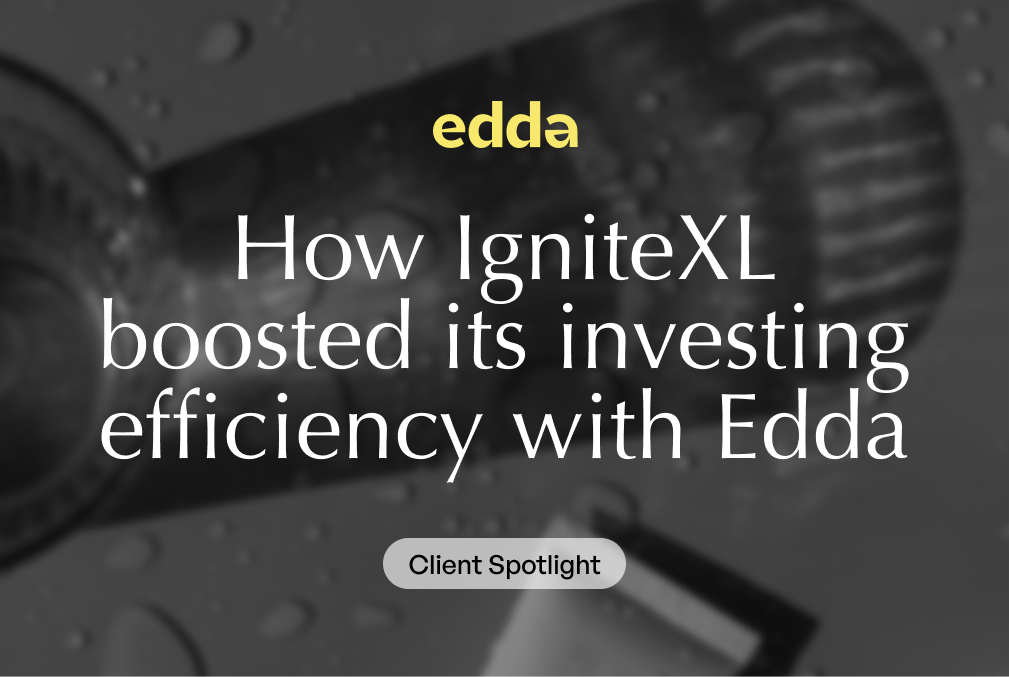Welcome back to Edda’s deep dive of fund performance analysis. In previous articles, we have discussed fundamental fund performance metrics such as IRR, TVPI, DPI and RVPI ratios. This article, however, will explore public market equivalents including the direct alpha method of assessing a fund’s performance.
The Foundation of Public Market Equivalent (PME)
Imagine you were investing in a particular stock market index such as S&P 500 for a period of ten years. Whenever you sell, you get a return. And now imagine that whenever a VC fund makes a capital call, it is exactly like investing in a stock market index and when the VC fund makes a distribution to its partners it is similar to selling the stock market index shares.
This is exactly the concept of PME. There are many different forms of PME such as Long Nickels PME, Kaplan and Schoar PME (KS PME), PME+ developed by Capital Dynamics, and mPME developed by Cambridge Associates. In addition, we will discuss the Direct Alpha method.
First, we must understand the foundation of PME.
The basic premise of PME is to calculate the future value of each cash flow as if they were invested in a stock market index. The formula to calculate future value is given below:

Let’s illustrate this with an example:
Assume on Dec 31, 2007 a VC fund made a capital call of $100 million and currently the date is Dec 31, 2017. The value of S&P 500 on Dec 31, 2007 was 1411.63 and the value of S&P 500 on Dec 31,2017 was 2743.15. Therefore, the future value of this cash flow is:

Long Nickels Index Comparison Method (ICM/PME)
The Long Nickels index comparison method was proposed by Austin M. Long III and Craig J. Nickels in 1996. It is considered to be the oldest and first PME method of assessing the performance of a VC fund. The basic idea of Long Nickels method is that the cash flows of a VC fund i.e. contributions and distributions are invested in a stock market index and to generate a net asset value (NAV) at the end of each period. The last NAV is used to calculate the IRR and this IRR is the Long Nickels PME.
For comparison, two IRRs are calculated, one is the fund IRR and the other is Long Nickels IRR. If the fund IRR is greater than Long Nickels IRR then the fund provided excess returns compared to the stock index and vice versa. Let’s illustrate Long Nickels PME with an example.
The data below shows the contributions and distributions of a VC fund along with the S&P 500 index value. The “index value change” column shows the percentage increase or decrease in the S&P 500 value

Net Asset Value (NAV)
At this point, we will calculate the Net Asset Value (NAV) at the end of each period. Here we will regard the contributions as positive cash flow and distributions as negative cash flow. The logic behind this assumption is that contributions are considered the amount that is invested in the hypothetical stock market index and this determines the net asset value. On the other hand, distributions is the amount paid back during the sale of stock index fund which decreases the NAV. For the purpose of calculation, only the last NAV will be taken into the final calculation of LN PME.

Lastly, we will calculate the net cash flow and find the IRR of Net cash flows. The NAV for the last period i.e. Jan 1, 2014 will be the NAV (ICM) we calculated above is 30.

Here, the fund IRR is 15% and the Long Nickels IRR is 12%. Hence the fund gave 3% excess returns compared to S&P 500 index.
Limitations of Long Nickels PME
The biggest drawback of LN PME is that a strong out-performance or under-performance can affect the IRR and it can produce a null value. For instance, this can be seen in the below table where a strong out-performance has reduced the ICM IRR to zero.

PME+ Value In Fund Performance Estimation
In the 2003 paper, ‘Private equity benchmarking with PME+’, Christoph Rouvinez introduced a new way of benchmarking the performance of a PE fund by using a coefficient lambda (λ) or a scaling factor to discount the value of distributions so that the NAV of the index matches the NAV of the fund. The PME+ returns an IRR value of discounted distributions. After that the discounted distributions are used to calculate Net Cash Flow and PME+ IRR calculated. If the PME+ IRR is less than that of the fund’s IRR then the fund has outperformed the stock index and vice versa.
The formula used to calculate new distribution is: Distribution x λ
Let’s illustrate PME+ with an example. First, we will calculate λ, which is found by using trial and error. The NAV of PME+ calculations must be equal to the fund’s NAV. In our example the PME+ NAV must be equal to 70.

The calculations to determine lambda and the subsequent steps make PME+ more complicated compared to LN PME method. For our data set, the lambda is found to be 0.9273. Now we will use the value of lambda to calculate the adjusted value of distributions.

The PME+ IRR is 12% while the fund IRR is 15%. Hence the fund has outperformed the stock market index.
Limitations of PME+
One of the challenges with computing PME+ is that the calculations are not simple. Secondly the usage of a single scaling factor λ is also sensitive to strong outperformance or underperformance. PME+ suffers from the common limitations associated with IRR calculations.
Kaplan Schoar (KS PME)
Nine years after the Long Nickels PME was introduced, Steven N. Kaplan and Antoinette Schoar introduced the KS PME method in 2005. The objective of KS PME method was to address the shortcomings of Long Nickels PME. Instead of choosing an IRR measure, the KS PME represents a market adjusted equivalent of the Total Value to Paid-In-Capital (TVPI). KS PME is calculated by finding the future value of each contribution and distribution using the stock market index returns. The formula for KS PME is given below.

A KS PME multiplier equal to 1.0 means that the VC fund has delivered a performance equal to the stock market index. Therefore, a KS PME multiplier of more than 1.0 means that the VC fund performed better than the stock market index and a multiplier of less than 1.0 means that the VC fund provided returns lower than that of the stock market index. Currently, the KS PME is considered most superior and widely used PME.
Example: Let’s illustrate the KS PME method with an example. The future values will be calculated using the future value formula discussed at the beginning of this post.


The KS PME multiplier of 1.068 suggests that the VC fund performed marginally better than the public index. Higher the KS PME multiplier, higher or more substantial is the fund performance as compared to a stock market index.
Limitations of KS PME
The KS PME removes the IRR sensitivity problem of Long Nickels PME. However, it ignores the timing of cash flows.
Modified PME (mPME)
The modified PME or mPME was introduced by Cambridge associates in 2013. mPME is similar to PME+ in the sense that it uses a scaling factor. However, mPME uses different scaling factors for cash flows at different time intervals. Thus, it attempts to improve the limitations of PME+ where a single coefficient λ is used to scale all distributions. The steps to calculate mPME are the following:
1. Calculate the Distribution weight for each distribution using the formula:

2. Calculate a hypothetical NAV called NAVPME using the formula:

3. Calculate the weighted distribution using the formula:

4. Finally, the net cash flow is calculated using the adjusted distribution and the IRR of this net cash flow gives us the mPME IRR.
Let’s simplify the complicated mPME calculation with an example: The NAV in light grey shade is market determined NAV. First, we will determine the Dweight

After that, we will find the NAVPME, the column It/I(t-1) refers to index values, this will simplify the calculations:

Now we will calculate the adjusted value of distribution:

Finally, we will use the adjusted distribution to calculate the net cash flow and compute the mPME IRR.:

The mPME IRR is 13.91% whereas the fund’s IRR is 15%. Hence mPME IRR indicates that the fund performed marginally better than the stock market index.
Limitations of mPME
The mPME measure seeks to improve the Long Nickels PME just like the PME+ method. However, it again uses a scaling factor to adjust the distributions, hence it is prone to manipulation and sensitive to under or outperformance. It also doesn’t take the future value into account and as evident from our calculations, mPME is much difficult to compute.
Direct Alpha As A Fund Performance Method
The direct alpha method is the most recent one and it was introduced in 2014 by Oleg Gredil, Barry E Griffiths and Rudiger Strucke. In 2009, Grifiths had talked about the concept of alpha which basically refers to the excess return a VC/PE fund makes as compared to a public market index and also points to fund managers superior performance.
The concept of direct alpha is closely related to the KS PME as it uses the same method to calculate an IRR which is then compared to the fund’s IRR. However, the difference between KS PME and direct alpha method is that in direct alpha the under or out performance is quantified by calculating the compounded cash flows plus the fund’s NAV.
Let’s illustrate direct alpha with an example. The future value of both contributions and distributions is found by using the future value formula discussed at the beginning of this post.

The Direct Alpha IRR is calculated to be 3% while the fund IRR is 15%. Since the direct alpha IRR is lesser than that of the fund IRR, this means that the fund outperformed the market index. In conclusion, of all the PME methods, direct alpha is the only method that tries to overcome the limitations and provide an exact number of outperformances rather than giving an approximate value of outperformance.
References
- Long, A.M. III & Nickels, C.J. (1996). A Private Investment Benchmark. The University of Texas System, AIMR Conference on Venture Capital Investing.
- Rouvinez, C. (2003). Private equity benchmarking with PME+. Private Equity International, August, 34–38.
- Kaplan, S. & Schoar, A. (2005). Private Equity Performance: Returns, Persistence, and Capital Flows. Journal of Finance, 60, 1791–1823.
- Griffiths, B. (2009). Estimating Alpha in Private Equity, in Oliver Gottschalg (ed.), Private Equity Mathematics. 2009, PEI Media.
- Cambridge Associates (2013). New Method for Comparing Performance of Private Investments with Public Investments Introduced by Cambridge Associates.
- Gredil, Oleg and Griffiths, Barry E and Stucke, Rüdiger, (2014). Benchmarking Private Equity: The Direct Alpha Method.
- Capital Dynamics. (2015). Public benchmarking of private equity Quantifying the shortness issue of PME.









